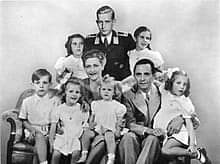THE GOEBBELS' CHILDREN: From Fateful Birth To Unfateful Death

Did you know that on May 1, 1945, Adolf Hitler's propaganda minister, Joseph Goebbels and his wife Magda Goebbels, slaughtered their six children and then committed suicide by taking cyanide?
The Goebbels children were the five daughters and one son born to Nazi propaganda minister Joseph Goebbels and his wife Magda Goebbels. The children (Helga, Holde, Hilde, Heide, Hedda and Helmut), born between 1932 and 1940, were murdered by their parents in Berlin on 1 May 1945, the day both parents committed suicide. Magda had an elder son, Harald Quandt, from a previous marriage to Günther Quandt. Harald, then aged 23, was a prisoner of war when his younger half-siblings were killed.
As the Red Army moved closer at the end of January 1945, Goebbels ordered that his family be moved from the Lanke estate to the relative safety of Schwanenwerder. From there, the children would soon hear the rumble of artillery in the east, and wonder why rain never followed the "thunder". By 22 April 1945, the day before the Red Army entered the outskirts of Berlin, the Goebbels moved their children into the Vorbunker, connected to the lower Führerbunker under the Reich Chancellery garden in central Berlin. Hitler and a few personnel were staying in the Führerbunker to direct the final defence of Berlin. German Red Cross leader SS-Gruppenführer Karl Gebhardt wanted to take the children out of the city with him, but was dismissed.
Stories of brutality and rape by the advancing Soviet troops were circulating in Berlin, and there was much discussion in the Führerbunker about suicide as a means to escape humiliation or punishment by the Soviets. Joseph Goebbels added a postscript to Hitler's last will and testament, stating that he would disobey the order to leave Berlin: "For reasons of humanity and personal loyalty" he had to stay. Further, his wife and their children supported his refusal to leave Berlin and his resolution to die in the bunker. He later qualified this by stating that the children would support the decision [to commit suicide] if they were old enough to speak for themselves.
Both pilot Hanna Reitsch (who had left the bunker on 29 April) and Junge (who left on 1 May) carried letters to the outside world from those remaining. Included was a letter from Magda to Harald, who was in an Allied POW camp.
On the following day, Magda and Joseph Goebbels arranged for an SS dentist, Sturmbannführer Helmut Kunz, to inject their six children with morphine so that, when they were unconscious, ampules of cyanide could be crushed in their mouths. According to Kunz's later testimony, he gave the children morphine injections, but it was Magda and SS-Obersturmbannführer Ludwig Stumpfegger, Hitler's personal doctor, who administered the cyanide. Rochus Misch, the bunker telephone/radio operator, stated that Werner Naumann told him that he had seen Hitler's personal physician, Dr Stumpfegger, give the children something "sweetened" to drink.
Magda appears to have contemplated and talked about killing her children at least a month in advance. After the war, Günther Quandt's sister-in-law Eleanore recalled Magda saying she did not want her children to grow up hearing that their father had been one of the century's foremost criminals and that reincarnation might grant her children a better future life. She refused several offers from others, such as Albert Speer, to take the children out of Berlin. The children seemed unaware of the impending danger, but the eldest child, Helga, seemed to sense that the adults were lying to her about the outcome of the war and asked what would happen to them.
Misch was among the last to see the children alive. They were seated around a table in his work area as their mother combed their hair and kissed them, all wearing nightgowns as it was close to their bedtime. Heide, the youngest, had scrambled up onto the table. Helga, whom Misch called the brightest of the children, was "crying softly" just before bedtime on that final night and wore a glum expression. Misch felt Helga had little fondness for her mother. Magda had to push Helga towards the stairs that led up to the Vorbunker. Four-year-old Heide, who had tonsilitis and wore a scarf around her neck, turned back to look at Misch, giggling, and teasingly said, "Misch, Misch, du bist ein Fisch", or "Misch, Misch, you are a fish", just before her mother led her and her siblings upstairs.
Misch recalled later that he suspected what was about to happen and would always regret not intervening.
When Soviet troops searched the bunker two days later, on 3 May 1945, the day after Soviet troops led by Lt. Col. Ivan Klimenko had discovered the burned bodies of their parents in the courtyard above, they found the children down in the Vorbunker dressed in their night clothes, with ribbons tied in the girls' hair.
Vice Admiral Hans Voss was brought to the Chancellery garden to identify the bodies, as was Hans Fritzsche, a leading German radio commentator who had answered directly to Goebbels. Their bodies were brought to the Buchau Cemetery in Berlin for autopsy and inquest by Soviet doctors. In spite of repeated attempts, even Frau Behrend, the children's grandmother, never learned what became of the bodies. Thereafter, the remains of the Goebbels family, General Krebs, and Hitler's dogs (thought to be Blondi and her offspring, Wulf) were repeatedly buried and exhumed.
The last burial was at the SMERSH facility in Magdeburg on 21 February 1946. In 1970, KGB director Yuri Andropov authorised an operation to destroy the remains. On 4 April 1970, a Soviet KGB team used detailed burial charts to exhume five wooden boxes at the Magdeburg SMERSH facility. The remains from the boxes were burned, crushed, and scattered into the Biederitz river, a tributary of the nearby Elbe.
In 2005, Rochus Misch attracted controversy when he called for a memorial plaque to be installed in honour of the six Goebbels children. Critics felt it would taint the memory of Holocaust victims to honor the children of the Nazi leader. Despite their parents' crimes, Misch argued that the children themselves were innocent, that to treat them as criminals like their parents was wrong and that they were murdered just as other victims during the war were murdered.
Source: Wikipedia
#penglobalhistory



